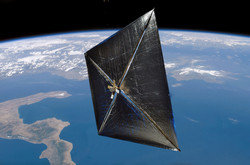Solar sails make space environment safer
Recent studies have revealed an increasing probability of collisions between intact spacecraft and space debris. This is because the historical practice of abandoning spacecraft and upper stages at the end-of-mission life has resulted in 5 500 tonnes of space debris in low Earth orbit (LEO). Operators of space systems must take measures to protect the space environment, particularly the LEO region – 2 000 km or less above the Earth. The European Code of Conduct for Space Debris Mitigation requires that satellites in the LEO-protected region are disposed of by destructive re-entry in the atmosphere within 25 years of the end of their working life. The DEORBIT SAIL(opens in new window) (De-Orbiting of Satellites using Solar Sails) project provided a low-cost and effective deorbiting solution. The project demonstrated that deorbiting can be achieved using a deployable ‘sail’ from a 3U CubeSat, a microsatellite used for space research. A deorbiting system moves the satellite out of crowded orbits, either to an area of space that isn't heavily populated or back down to Earth. The DeOrbitSail satellite will return to Earth and burn up in the atmosphere by using the drag from its deployable sail to lower its orbit. Project partners highlighted the benefits of low-mass-to-sail-area missions by using the CubeSat platform, thereby avoiding the costs and technical challenges of developing large spacecraft. The sail comprises a 4 x 4 m square comprising 4 triangles supported by 4 relatively stiff structural booms. A motor deploys the booms from a compartment at one end of the satellite. The complete satellite fits into a standard 3U CubeSat deployer, the ISIPOD, and weighs less than 4 kg. Scientists manufactured and tested both payload subsystems, namely the deployable sail and the attitude and control system. The team successfully tested the three-axis control system, the boom deployment system and the large cantilevered deployable solar panels, and designed the flight model. After a successful launch (10 July 2015), the satellite is healthy, power safe and with great communications through newly developed software defined radio and database backend operations. On the 15th of August, the first attempt for sail deployment was performed. Today, after a thorough investigation, the most plausible hypothesis and justification is a physical disconnection of the motor cables. The aim now is to exercise and exploit the parts of the satellite that are working, and gain more confidence and experience with the SU ADCS system, the ISIS TRXUV and solar panels, and the SSC SDR groundstation and database tools, to explore better the interaction of the solar panel circuitry with the attitude stabilisation.







